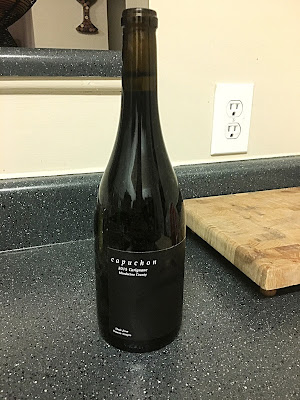
This weeks wine is a different vintage of a wine I tried in late January. The 2015 vintage tasted dramatically different from the 2016. The 2016 was bright, fun, and easy drinking, with a bit of complexity sneaking up on you, whereas the 2015 was much more brooding of a wine. I actually think I liked the 2016 better. I got this wine from Winc, and it's from the Mendocino Valley of California. The wine is a California take on a Rhone style wine, and it's not a bad substitute.
You may have noticed in the top left picture that there are bubbles in the wine. This isn't because the wine is carbonated or anything like that, it's because I took the picture immediately after I had poured the wine into the glass through an aerator. I think I've mentioned using an aerator before, but I haven't delved into all the benefits of them. In a nutshell, aeration gets more oxygen into the wine. There are other ways of aerating than pouring through an aerator. Swirling your wine in the glass aerates it, as does just leaving the bottle open for a bit before you drink it. This is commonly referred to as letting the wine "breath." I like using an aerator, because it's easy and quick. I can open a bottle of wine a few minutes before I want to drink it, and not worry that it won't have time to aerate before pouring a glass.
The science behind aeration is that two processes are actually happening, oxidation and evaporation. Evaporation is important because during the wine-making process compounds that detract from, instead of enhancing, the flavor and aroma and the wine can make their way into the wine. This is a normal side effect of wine-making, but we still want to counteract that if we can. These not so great compounds evaporate much faster than the ones that give wine its delicious, juicy, and complex flavors. So speeding up the evaporation process at the beginning gets rid of some of the bad flavors and leads the good ones behind. The oxidation process does something different, it softens flavors in the wine and released aromas. This can lead to a more balanced tasting wine.
I aerate most of the red wines that I drink, but it's not something that needs to, or should be, done to every wine. I typically buy red wines that are less than ten years old and are in the $15-$35 price range. These wines can generally really benefit from aeration. Aeration can make your $20 wine taste like a $50-$60 wine. It just makes the wine taste better. I took a sip of the Capuchon Carignane before aerating and it just tasted flat, boring, and a little too bitter. After I aerated it, there was a larger variety of aromas coming from it and it tasted more balanced. It's a wine that really benefited from aeration. I wouldn't aerate a delicate older red wine though. Instead, I would open it a little early to let it breath and swirl it in my glass for a little bit before drinking. A wine like that doesn't benefit from a faster aeration process, it needs it much slower and gradual, otherwise the wine can be damaged. I also wouldn't aerate most white wines, some full bodied French whites, like a White Bordeaux, can benefit from aeration, but the vast majority of whites don't need it.
The type of wine glass you use can also help with oxidation. My fiance and I got these wine glasses as an engagement present and we love them so far. They're bigger than my usual red wine glasses, so there's more open space between the top of the wine and the top of the glass, and the top of the glass has a larger circumference. Both of these things help get more oxygen to the wine as I drink it, and like aeration, makes the wine taste smoother.


I've spent a lot of time writing about aeration, I'll move on to the actual wine now. This wine had strong pepper and tobacco aromas, with a hint of red cherry and strawberry. I could tell from the smell that this wine wasn't going to be as fruit forward as the 2016 vintage, and I was right. When I drank the wine the red cherry and strawberry notes were a bit stronger than they smelled, but they were quickly overshadowed by the back end notes of pepper, tobacco, a hint of dirt, and a hint of cinnamon. I mentioned earlier that this wine was more brooding than the 2016, but it almost tasted like it was trying too hard to be brooding. I wished this wine had been a bit brighter and that the fruit flavors could have shone more.
I drank this wine after dinner, by itself. I had shrimp for dinner, so I didn't want to drink the wine with the shrimp, because they would not have paired well together. I think this wine would go well with a cheese and charcuterie plate; with some prosciutto, salami, or smoked gouda. It would also go well with a heavier chicken dish, like chicken teriyaki. I'm not sure that I would buy this wine again, but I'll definitely finish the bottle.


Aerator: Amazon.
Wine Glasses: Kate Spade.


No comments:
Post a Comment